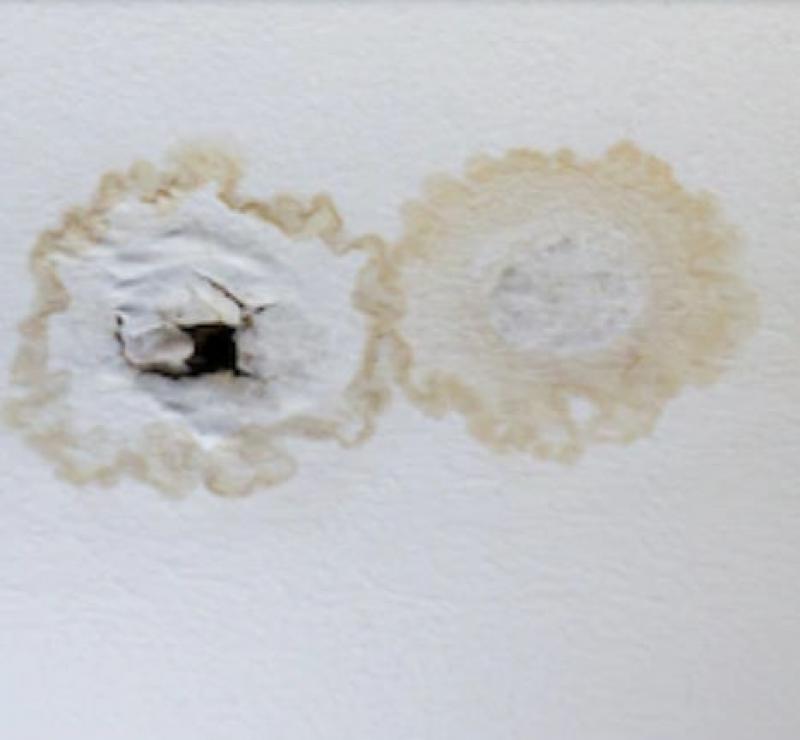Do You Need a New Roof? Twelve Warning Signs
by Guest Post on May 7, 2012
As any homeowner knows (and cringes whenever they think about it), the roof of their home is far from permanent. Although it's generally made of the toughest economical materials available, in most house designs the roof is the part of the house that absorbs the most punishment. It sits there, day after day, quietly taking a beating from the sun, wind, and weather, and hardly makes a complaint -- until one day, you realize it's about had all it can take and needs to be replaced.
Sometimes this is as obvious as a great big hole gushing ten gallons of water a minute in the middle of a rainstorm, but most of the time it's not so clear: you have to risk life and limb to check the roof firsthand to see how it's doing. This is the point where you sigh, dig your ladders out of the mess in the garage, and prepare to climb. (Incidentally, in the interests of safety, you should always use a specialized, extra-sturdy ladder like the Little Giant ladder system. After all, this is home improvement, not the X-Games, so safe equipment like Little Giant ladders are mandatory.
What to look for first
Your first mission is to check the ceiling inside your home. There might be a small leak somewhere that'll show up first as a spot on the ceiling. Once your ceiling inspection is completed, it's time to take a little trip into the attic. Unless you have one of those unique house plans (and by "unique" we mean "weird"), your attic should be easily accessed from a hatch that has its drop-down ladder -- no special indoor Little Giant ladder accessories needed (awwww!). Scamper up there with your flashlight and take a close look at the attic ceiling and supports, especially around the air vents and along the sides of beams. Here's what to look for:
- Sagging of the roof deck
- Dark spots and trails
- Obvious water stains
- Outside light visible through the roof
If you see any of these problems, then you'll want to do a thorough exterior inspection.
What to look for on the roof
You don't have to get up onto the roof, but you should at least get up there and take a good, hard look. Here's what to keep an eye out for:
- Damaged or corroded flashing (the metal sheeting around the chimney and such)
- Missing shingles
- Curling or blistered shingles
- Sagging (indicating problems in the roof deck)
- Buckling (when shingles are push up in a "peak")
- Algal growth (dark or greenish stains)
- Rotten wood
- Missing granules on asphalt shingles
Even if you don't see missing granules on your shingles, check your rain gutters. Under all those leaves you should have cleaned out last November you're likely to find a layer of what appears to be dark soil. Some of this may be humus from rotten leaves, but if you encounter lots of coarser, sandy particles, you've probably found your granules. (This is assuming that you don't live somewhere where they have lots of sandstorms, like West Texas). Finally, if you have a roof with wooden shakes rather than composite shingles (an increasingly rare case in these fire-conscious days), then you should also look for splitting and (*shudder*) termite damage.
If you find some of these warning signs, don't despair: by themselves, they don't always mean you need a new roof, though you certainly do if all or most are present. Blisters can be popped with a knife and repaired with roofing cement, and damaged, missing, and algae-invaded shingles can be individually replaced. Separations in flashing and small depression near vents and pipes are also easily repaired, either by you or someone you trust.
Popular Articles
Three Places to Spend Money on the Exterior of Your Home
When you have the exterior of your home remodeled, you are investing, time, energy and convenience into the project and you want to make sure that...
104899 Views
Homemade Headboards-Make an Upholstered or Wooden Headboard
Homemade headboards can add a lot of personality to any bedroom. They can be coordinated with existing furniture and room decor or they can be the...
80133 Views
When to Use a Brush, Roller or Sponge Brush
Brushes are a good choice for painting trim and woodwork. They are also useful for cutting in the edges around the top and bottom edges and corners...
72805 Views
Creating a Cottage Kitchen with Bead Board
Kitchen decor can range from modern and bold to elegant and elaborate by using strategic kitchen pieces. One of the most popular decorating trends...
58562 Views
Gas Fireplace Diagnostics and Troubleshooting
Follow these steps for diagnosing and troubleshooting Gas Fireplaces repairs. For the average DIYer, this may seem intimidating, depending on the...
35599 Views
Latest Articles
How Much Does it Cost to Take a Bath?
Plumbers know that a bath may seem like a relaxing luxury, but the real cost extends far beyond your water bill. The average soak uses 35 to 50...
on Apr 8, 2025
10 Concrete Patio Ideas on a Budget
A concrete patio can be a game-changer for your outdoor space. It is durable, versatile, and can be customized to fit your style. But what if you...
on Mar 25, 2025
Tips for Creating a Stunning Personalized Photo on Canvas
Order the unique beauty of a personalized photo on canvas and bring your memories to life. With a customized photo on canvas, you can transform...
on Mar 7, 2025
Best Areas to Buy Property in Singapore for Long-Term Growth
Singapore's real estate market remains one of the most stable and lucrative in the world. With limited land supply, strong governmental...
on Feb 18, 2025
Troubleshooting Excess Water in Your HVAC Secondary Condensate Drain Pan
When maintaining your air conditioning system, it is easy to overlook the condensate drain pan - until excess water starts pooling in places where...
on Jan 12, 2025
Featured Articles
What Type of Licensed Contractor Should You Hire?
on Feb 28, 2017
Hire Contractors / Estimates

Looking for a specialty project? There are many types of contractors available for your home improvement needs. Finding the right type of...
Sponsored Articles
Best Areas to Buy Property in Singapore for Long-Term Growth
on Feb 18, 2025
Real Estate / Finance

Singapore's real estate market remains one of the most stable and lucrative in the world. With limited land supply, strong governmental...
Actions
Top Categories
- Garden / Landscaping / Patio — 264
- Kitchen / Bathrooms — 240
- Real Estate / Finance — 203
- Appliance / Repair — 186
- Interior Design / Decor — 184
- HVAC / Air Conditioning — 148
- Cleaning / Maintenance — 144
- Improvements / Remodeling — 131
- Plumbing / Basements — 118
- Floors / Tile / Hardwood — 116
- Doors / Garages — 113
- Safety / Security — 113
Articles Archive
More DIY Articles
Can I Clean My Home’s Air Ducts Myself?
As a DIYer, we love to save money and do things just like the pros do. So what about HVAC systems? Is it possible to clean your own air ducts,...
Is Gas Heating Right for Your Patio?
Patio heaters are ideal for those people who want to spend more time enjoying their gardens in the colder months of the year. There can be plenty...
7 Home Improvement Projects That Improve Privacy
If you’re building or renovating a home, there are a lot of things to consider. You’ve probably spent countless hours choosing materials, color...
Gun Safe - Securing Your Property and Family
Due to different reasons, taking the steps to secure your property and family will need the right device like a gun that is available in your home...
6 Easy Tips to Sell Your House Fast
If you’re in the market to sell your house, you might find yourself constantly overwhelmed and stressed about this project. Selling a house is no...

